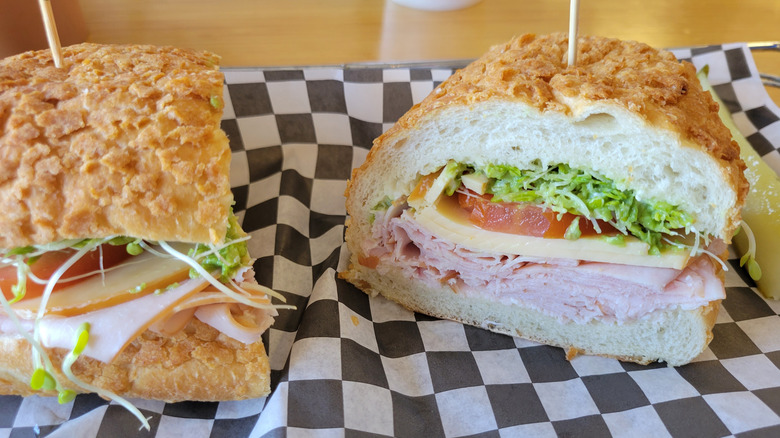Sandwiches In California's Bay Area Hit Different Thanks To This Bread
When it comes to regional food inventions and legacies, the Bay Area can stack up pound for pound with anywhere else. Sourdough bread, Rice-A-Roni, It's-it ice cream sandwiches, Vietnamese garlic noodles, fortune cookies, Mai Tais, and of course, Mission-style burritos, the Bay's imprint on the culinary scene is indelible. One region-specific food item you might not know about is the city's favorite bread (outside of sourdough), which is, strangely, somewhat harder to find once you leave the Northern Californian metropolis: Dutch crunch.
Dutch crunch is the perfect sandwich bread. With a hard exterior lined by tectonic cracks in the crust and a soft, absorbent interior, the bread is perfect for handling vegetables and sauces without falling apart — all while giving you the textural contrast you crave. It gets its unique topography from a thick paste made from yeast, white rice flour, sugar, water, salt, and oil, which is then spread over the top of the dough once it rises. As the loaf bakes, the paste hardens into the shell that makes the bread so iconic.
The only downside is that if you bite into it with too much enthusiasm, there's a decent chance you'll wake up the next day with the roof of your mouth torn up worse than a kitten playing with a house plant. Luckily, there's a time-honored Bay Area tradition to get around that: Flip the sandwich upside down to enjoy all the flavor with none of the pain.
Dutch crunch's past, present, and future
Prevailing wisdom is that Dutch crunch bread was popularized by Galli's Sanitary Bakery in the 1960s, and to this day, it's kept popular by places like Ike's Sandwiches and Bite Me Sandwiches. Roma Deli in San Bruno, just south of the city, is another well-regarded sandwich shop, and its salami sandwich is loaded with pickles, lettuce, onions, and a combination of mustard and garlic sauce that creates a divine fusion on the iconic bread.
As the name might imply, though, this particular kind of loaf didn't originate in the Bay. Also known by the name tiger bread, it was invented in the Netherlands before making the trans-Atlantic journey to wind up in San Francisco, taking a quick pitstop in Eugene, Oregon, along the way in the 1930s. Given that tigers, and rice for that matter, are not exactly native to Amsterdam, it's believed that the creation of this bread has roots in Dutch colonization of Indonesia in the 1600s.
It has long been a mystery why Dutch crunch hasn't gained more of a toehold outside of the Bay Area. However, the winds of change are starting to shift, and the bread is becoming more popular outside of its Northern California bubble. This is thanks to the influence of their northern statesmen and the spread of regional chains like Ike's, which started at a San Francisco family market and now boasts over 100 locations across California and the southwest, spreading the good word of Dutch crunch as far east as Louisiana.


